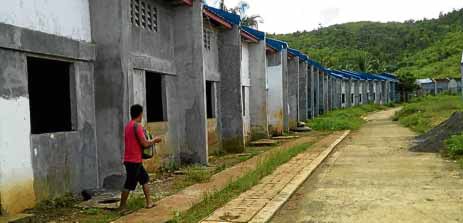
EMPTY DWELLINGS Houses still under construction at a relocation site for typhoon survivors in General Mac Arthur, Eastern Samar, appear deserted. A founder of People Surge, an organization of survivors, said the houses were not only poorly built but also not well planned, as shown by the lack of basic amenities. CONTRIBUTED PHOTO
(First of three parts)
TACLOBAN CITY — Imelda Tacalan is angry.
She and her family have yet to be relocated to a new home promised by the government after they lost their house to Supertyphoon “Yolanda” (international name: Haiyan) on this day in 2013.
But what she finds more revolting is that the government wants them to move into a house that has been built with material so flimsy that a slight punch can make a hole through the wall that connects it to the next house in the row.
Tacalan, 48, is just one of the thousands of Yolanda survivors who are still waiting to be relocated five years after the government promised to give them new houses through the National Housing Authority (NHA).
The promised houses have not been completed.
According to the 2017 Commission on Audit (COA) annual report released in August, only 41 percent (84,295) of the 205,128 houses for the typhoon victims had been completed.
Of that number, only 28,395 houses, or 34 percent, had been occupied. The rest — 55,900 houses, or 66 percent — had not been completed.
Among the reasons for the delay in the completion of the houses, according to the COA, are lack of basic facilities, incomplete structural components and construction defects.
Tacalan says her family is supposed to be among the 460 families who were to occupy the NHA houses at Barangay Cansumangkay, Balangiga town, Eastern Samar.
But they refused to move in because they felt unsafe in the flimsy houses.
Tacalan says her neighbors also found the location too far from their old fishing village — 4 kilometers away — since most of them were fishermen.
But Dorcas Secreto, the NHA’s regional management estate specialist in Eastern Visayas, dismisses claims that the houses are substandard, saying the designs and specifications were submitted by the contractors to the Department of Public Works and Highways (DPWH) for scrutiny and approval.
Secreto says the complaints about wobbling and cracking walls are just “construction defects [that] could be repaired.”
She says the NHA should not be blamed for the locations because these were chosen by the the local governments.
The provision of power and water at the relocation sites was supposed to be taken care of by other government agencies, she says.
But Efleda Bautista, one of the founders of People Surge, an organization of Yolanda survivors, says the houses are not only poorly built but also not well-planned, as shown by the lack of basic amenities.
“It’s like being hit again by Yolanda. There is no day that they don’t fear for their lives and the lives of their children,” says Bautista, a former college professor.
Contractor not charged
“When it rains, the relocation sites get flooded (due to the lack of drainage) and on sunny days, the heat is unbearable. They have to line up for potable water rationed to them,” she says.
A contractor in Eastern Samar has been blacklisted after investigation by the committee on urban and development of the House of Representatives showed it used substandard materials for the houses.
But Eastern Samar Rep. Ben Evardone, a member of the House committee on housing and urban development, says no formal complaint has been filed against the contractor or any NHA official.
The contractor has been signed up to build 2,259 houses in the towns of Balangiga, (460), Quinapondan (810) and Hernani (989).
All these houses remain incomplete.
Mayor Edgar Boco of Hernani says a new contractor is set take over the construction of houses this month and complete the work in six months.
He feels bad his constituents have not been relocated five years after the tragedy struck.
“Up to now, these families continue to live in their barangays that have been declared danger zones because these are located along the coasts. They cannot move out because the housing project is not yet done. I really pity them,” Boco says.
He says he went to the housing project at Barangay Canciledes, Hernani, which cost about P270 million, and found that the steel bars are already rusty.
“Imagine the waste of money here. We proposed that the fund be downloaded to the local government so we could construct these houses. This would have made us directly accountable. But this did not happen,” he says.
Boco hopes the housing project would be finished before the sixth anniversary of Yolanda next year, a sentiment shared by the typhoon survivors.
RELATED VIDEO